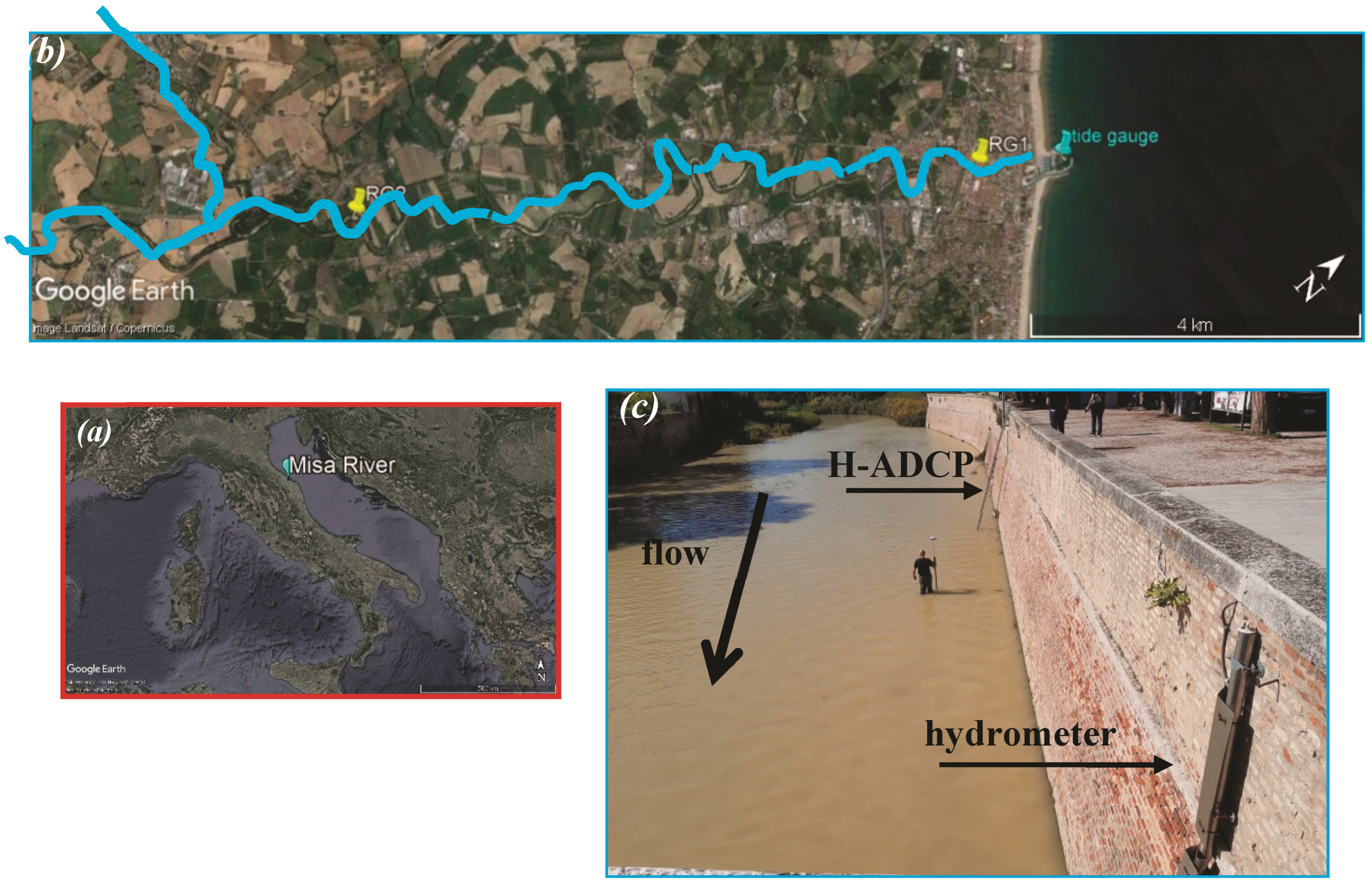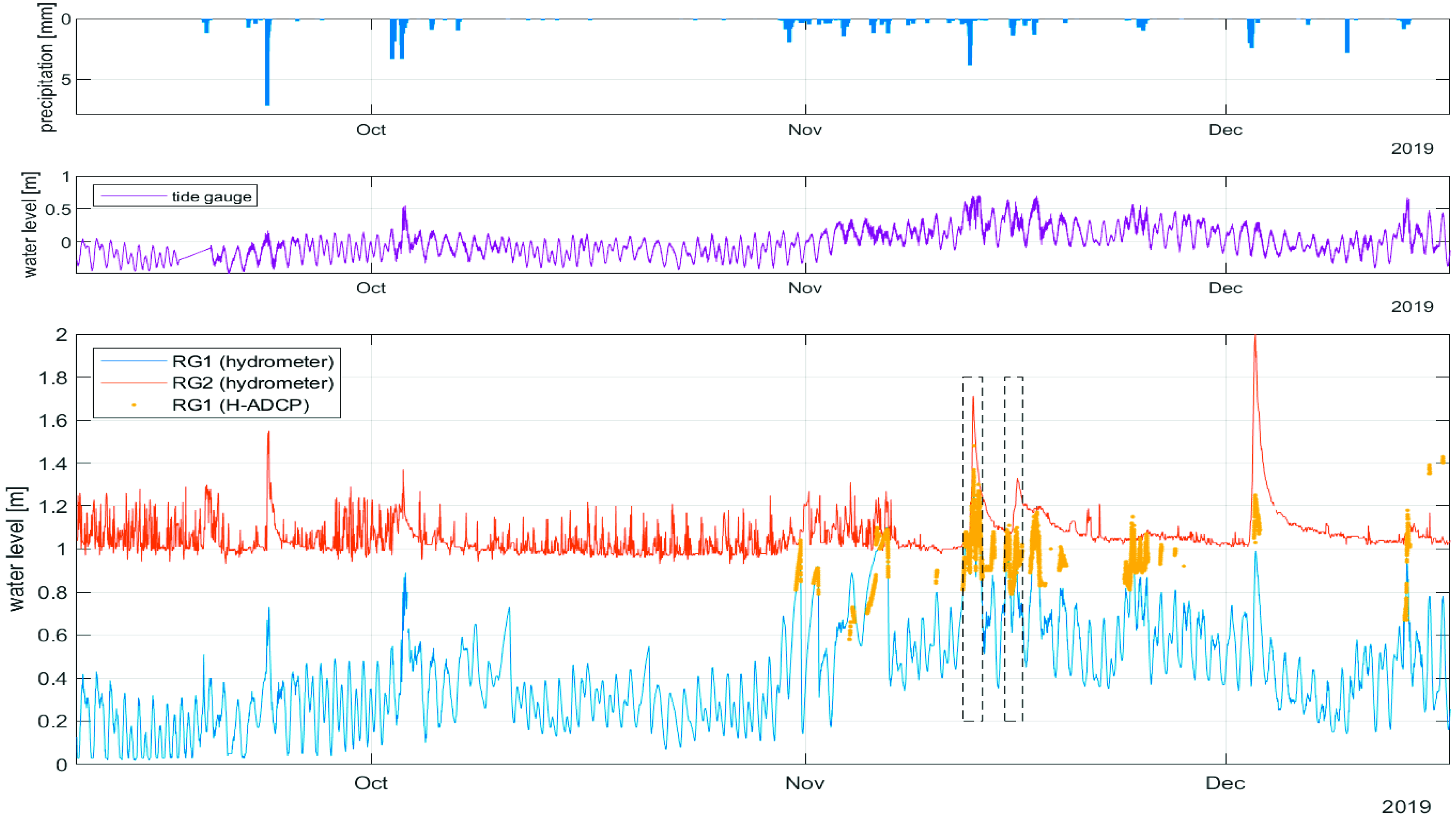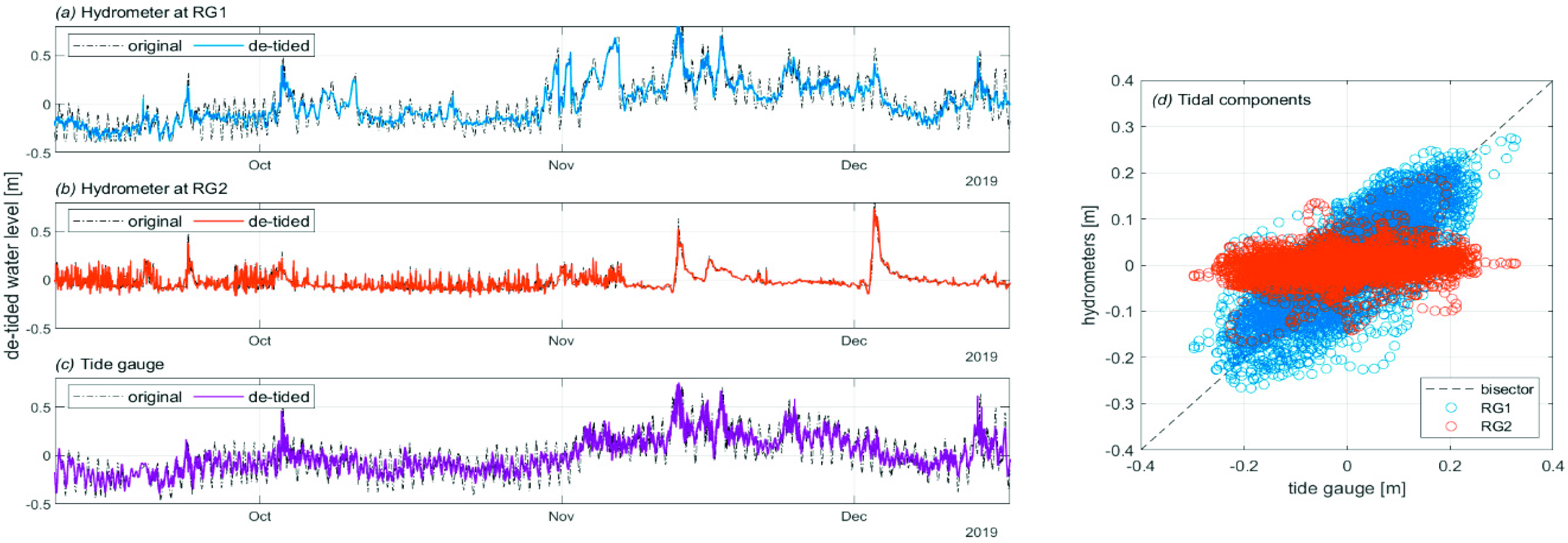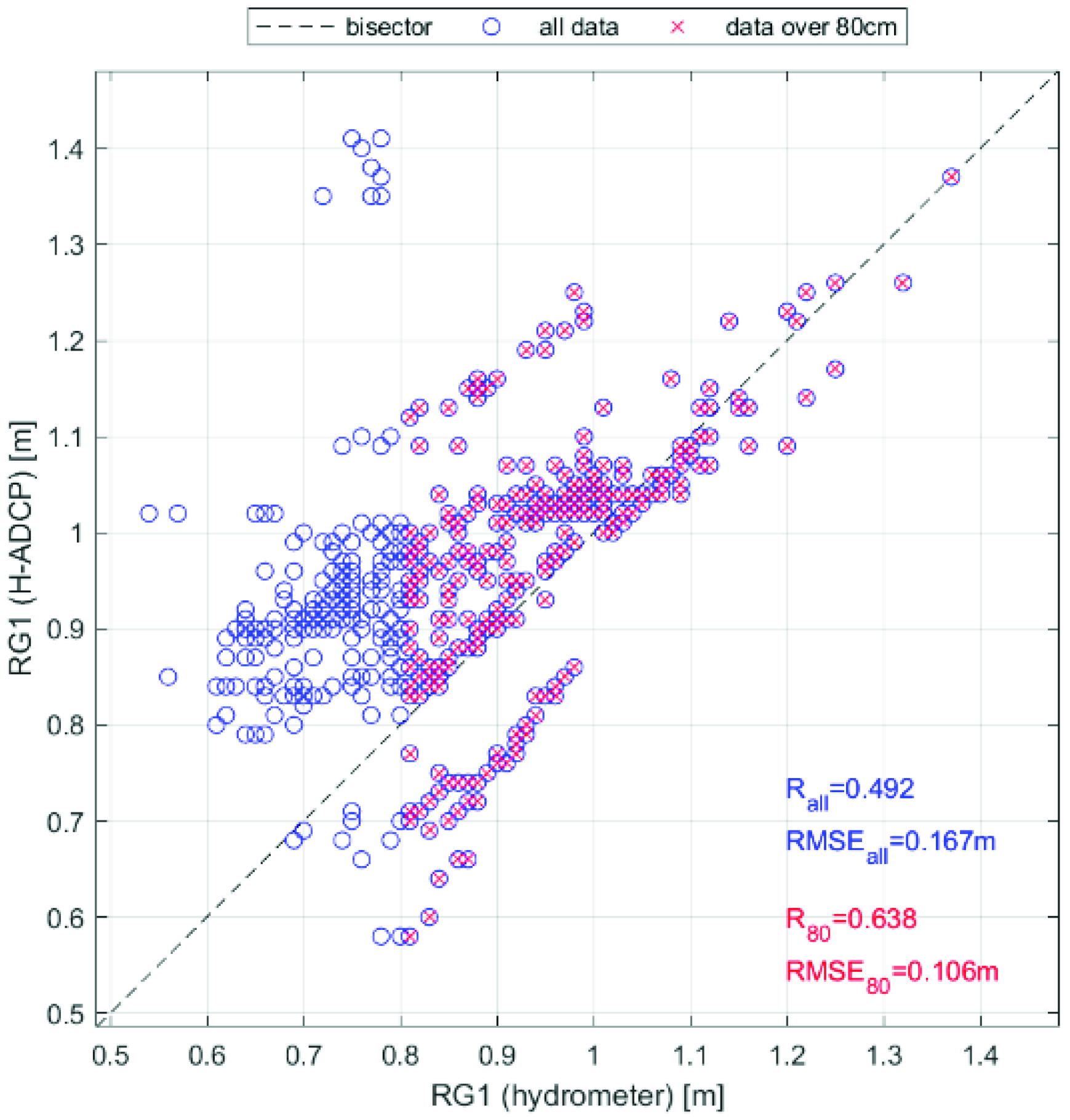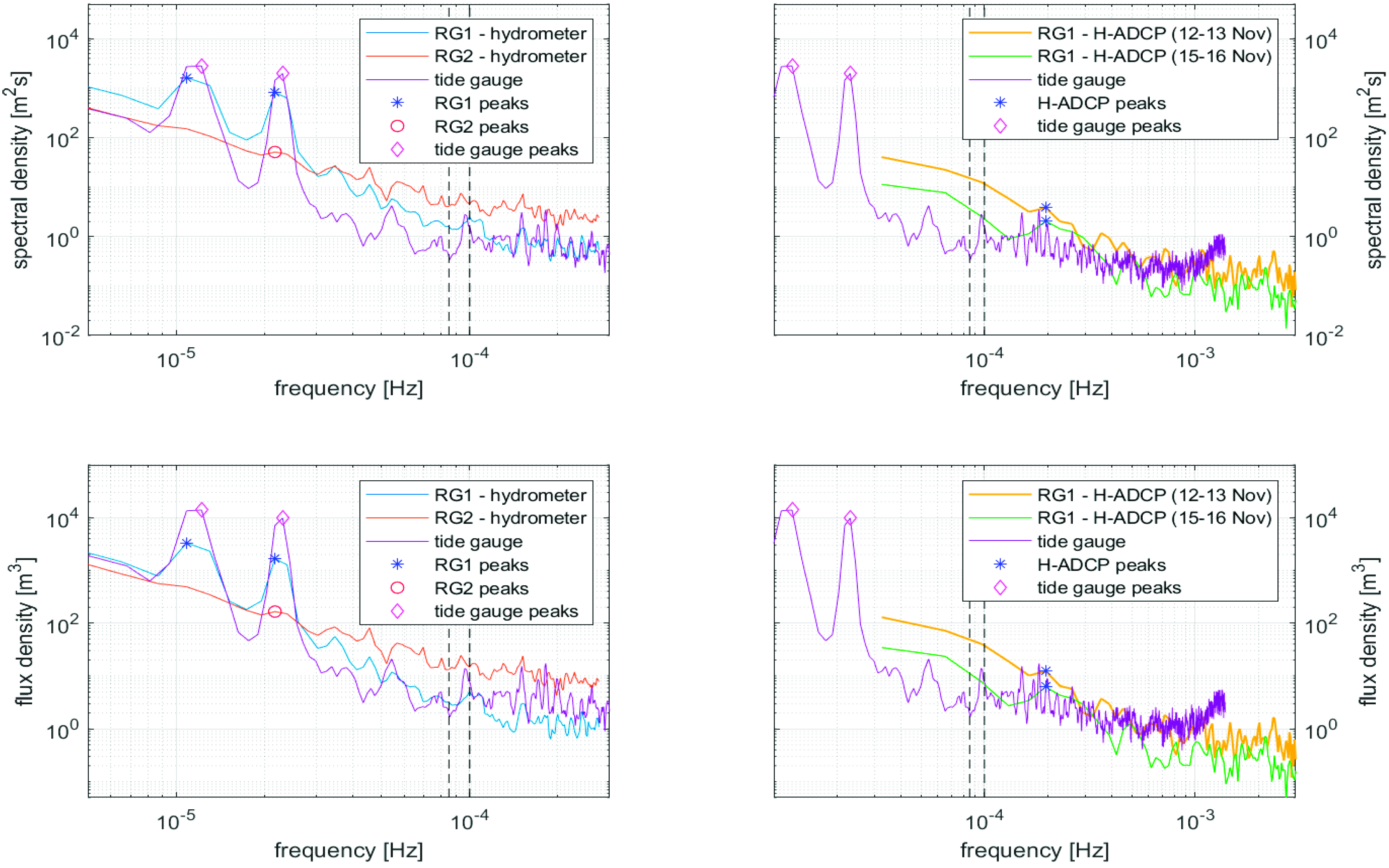The flow in the final MR stretch is affected by many forcing actions. Specifically, the river discharge is modulated by the sea entering the estuary and propagating upriver. Hence, to give evidence of such behavior, the data collected by the sensors located at RG1, RG2 and Senigallia harbor are analyzed.
3.1. Analysis of the Collected Data
The time series of the latest events recorded between September and December 2019 are illustrated in
Figure 2, where the mean precipitation level measured in the MR watershed is also shown (top panel). The tide-gauge series is shifted vertically and oscillates around the time-averaged level (middle panel). The water-level recorded by the hydrometers located at RG1 (blue line) and RG2 (red line) refer to the riverbed level, as well as the water level collected by the H-ADCP (yellow dots) at RG1 (bottom panel). Comparing the hydrometer time series, more frequent oscillations are observed at Ponte Garibaldi, where the tidal forcing is much stronger than at Bettolelle, as also visible if compared to the tide-gauge series (see also [
10]). Additional peaks are observed at both locations and are fairly evident in the investigated wintertime period, especially because of the more frequent precipitations and larger runoff in the MR watershed. The main peaks correspond to the intense precipitations occurring in 23 September (15-min precipitation of about 7 mm) and 2–3 October (about 3 mm). However, such events did not lead to significantly high water levels in the MR, probably due to a relatively dry watershed in such periods. Hence, the H-ADCP was not submerged and did not provide any measure. Conversely, relatively weaker but long-lasting events (e.g., those occurring at the beginning of November) combined with more intense precipitations (~4 mm in 12 November) led to higher water levels and enabled the H-ADCP to be submerged and properly collect data.
In addition to short events that occurred between October and December 2019, a couple of relatively long events can be observed in
Figure 2 (black rectangles), both lasting a bit more than one day, i.e., one between 12 and 13 November, the other between 15 and 16 November. The spectral content of these events is discussed in the following sections.
To better understand the dependence of the role of tide within the MR,
Figure 3a–c illustrates both original (dash-dotted black lines) and de-tided signals, obtained by filtering out periods in the 12–24 h range (colored solid lines). Each series is vertically shifted by a quantity equal to its time average. The main difference among the recordings is that the tidal component, i.e., that related to periods in the range 12–24 h, is almost absent at RG2 (
Figure 3b), with original and de-tided signals almost overlapping. Conversely, the tide plays an important role at both RG1 (
Figure 3a) and harbor (
Figure 3c).
The dependence of each signal on the tidal constituents can better be seen in
Figure 3d, where the tidal component recorded by the tide gauge is plotted against the same component recorded by both hydrometers. The data related to the RG1 hydrometer fall around the bisector, demonstrating a strong correlation with the tidal forcing. Conversely, the tidal component recorded at RG2 distributes around zero, thus showing a weak dependence on the tidal forcing.
The influence of the sea forcing at RG1 is confirmed by the larger de-tided surface levels observed during some events, simultaneously recorded by the tide gauge, e.g., at the beginning of October, around the middle of November and the end of December (compare top and bottom panels). Conversely, the RG2 hydrometer seems to be the only one affected by more frequent perturbations, not occurring during the above-mentioned events (middle panel).
3.2. Data Comparison at RG1
From a first inspection of
Figure 2, the data collected by both instruments located at RG1 are in a relatively good agreement, with the H-ADCP sometimes providing larger values. The scatter plot of
Figure 4 better illustrates the comparison. In detail, due to the difference in the sampling rate of the two instruments (2’ versus 30’), only the H-ADCP data collected simultaneously with the hydrometer have been considered. Blue circles represent the whole data sets, in agreement with the time series of
Figure 2, while red crosses represent only the data referring to a water level larger than 80 cm, when the H-ADCP was completely submerged.
The correlation between the recorded signals has been evaluated using the correlation coefficient R and the RMSE coefficient. As shown in
Figure 4, the reduced sample provides better performances, with the RMSE passing from 0.167 to 0.106 m and the correlation significantly increasing. The main factors that can be attributed to such difference are the distance between the sensors, e.g., the hydrometer is much closer to the bridge, with the flow being slightly different; the instrument sampling rate and the consequent difference due to the averaging performed on the H-ADCP data.
For the following spectral analysis (
Section 3.3), all data falling in the chosen events (black rectangles in
Figure 2) are used. In such periods, water levels smaller than 80 cm only represent 3% of the data referring to the 15–16 November event, while all recorded water levels are over 80 cm in the 12–13 November event.
3.3. Spectral Analysis
The data collected by the hydrometers located at RG1 and RG2, the H-ADCP at RG1 and the tide gauge have been analyzed from the spectral viewpoint. The main features of the spectral analysis are reported in
Table 1.
Both spectral density and flux density, the latter being the product between the spectral density and the group velocity, are illustrated in
Figure 5, respectively, in the top and bottom panels. Due to the different sampling rates of the instruments in use and to better illustrate the spectral features of each of them, the x-axis limits have been adapted either to the hydrometer data (left panels) or to the H-ADCP data (right panels). Further, for comparison purposes, the spectral response of the tide gauge is illustrated in all panels.
The left panels refer to the hydrometer and tide-gauge data recorded between 10 September and 17 December 2019. The spectral behavior of both hydrometers is qualitatively similar in the lower reach of the spectra, i.e., for frequencies f > 0.5 × 10−4 Hz. However, a larger spectral density is observed at RG2, this being likely due to typical high-frequency oscillations occurring at more inland locations, where short-period perturbations are much more frequent than downstream. These are mainly due to a more irregular riverbed, a larger bed roughness and a steeper slope, all leading to a larger turbulence and to an intensity increase of high-frequency modes. On the other hand, significant differences are observed at smaller frequencies (f < 0.5 × 10−4 Hz). Peak values in both flux and spectral densities are more evident at RG1 (colored symbols), with peak frequencies referring to diurnal (~25.6 h) and semi-diurnal (~12.8 h) tidal constituents. At RG2, only the semidiurnal constituent exists, although its contribution is significantly poor. A comparable spectral density is obtained from the tide-gauge series, which again shows the highest peaks in correspondence with the diurnal and semi-diurnal tidal constituents, thus reinforcing the large importance of the tide both close to the coast (harbor) and 1 km inland of the river mouth (RG1).
An additional analysis (not shown here), performed using a reduced degree of freedom, shows a large amount of spectral density corresponding to periods around 30–40 days, which explains the oscillation observed in
Figure 2, evident for both the RG1 hydrometer and the tide gauge. Here, an increasing trend of the water level occurs between the end of October and November, while a decreasing trend characterizes the final part of November and the beginning of December.
The right panels of
Figure 5 represent both spectral and flux densities of two events recorded by the H-ADCP, located at RG1. These have been selected as the longest occurred in the investigated time range, and refer to 12–13 November (yellow lines) and 15–16 November (green lines), when both a significant amount of precipitation occurred and the river level at Ponte Garibaldi was high enough to submerge the H-ADCP (see also
Figure 2).
Figure 5 illustrates a large spectral contribution at relatively low frequencies, with the highest local peak corresponding to about 1.42 h (blue asterisks). Typical tidal constituents are smaller than the used frequency limits and cannot be individuated due to the reduced duration of the recorded events.
The analysis of
Figure 5 seems to suggest that a contribution may come from modes associated with the geometry of the Adriatic Sea basin, like the seiching motion. This characterizes enclosed and semi-enclosed basins and can be described through the following equation
where
Tseiche,n gives the natural periods of the seiche at a specific mode
n, while
L is the length of the basin,
h the average depth of the basin, and
g the gravity acceleration. The main modes in the Adriatic Sea are characterized by periods of 21.2 h, 10.7 h and 6.7 h, usually triggered by the Scirocco wind [
12,
13]. However, if one wants to account for the transversal seiche motion, shorter periods are found. Specifically, in the considered study site, the distance between Senigallia and the opposite coast of the Croatian islands is
L ~ 130 km. Since the depth along such distance is in the range
h = (50–70) m, the mode-1 transversal seiche motion is characterized by a period
Tseiche,1 = (2.8–3.3) h, i.e., by a frequency
fseiche = (0.85–1.0) × 10
−4 Hz. Such frequencies fall in the descending limbs of the curves (see intervals between black dashed lines in
Figure 5) for both hydrometers (left panels) and H-ADCP (right panels). In such ranges, the spectral density for the hydrometers is of order
O(1–10) m
2s (top left), in agreement with the events recorded by the H-ADCP, characterized by a spectral density of
O(1–10) m
2s (top right), but no peaks are observed, i.e., transversal seiching seems not to be perceived. Conversely, some peaks are observed in the tide-gauge series just outside the
fseiche region, i.e., at 0.54 × 10
−4 Hz (left of
fseiche region) and 0.96 × 10
−4 Hz (right of
fseiche region). This suggests a much more evident effect of the mode-1 seiching motion within the harbor, if compared to the effect within the MR, recorded by both hydrometers and H-ADCP.
On the other hand, the analysis of mode 2 leads to seiche periods in the range
Tseiche,2 = (1.38–1.63) h, which is consistent with the local peak observed at RG1 and corresponding to 1.42 h (right panels of
Figure 5). This can be seen as the possible explanation for the transversal oscillation of the Adriatic basin, which can be detected by means of high-frequency recordings during flood conditions of relatively small duration.
Such analysis reveals that perturbations characterized by the same frequency of the seiching motion are not particularly significant in the long term in the river, when tidal components are much more important, but in a relatively short term (order of hours to days), their contribution is important. Hence, the upriver propagation of seiches cannot be neglected.
Finally, the tide-gauge spectral density increases at frequencies f = (1.2–1.4) × 10−3 Hz and is larger than that observed at RG1. Such frequency range corresponds to periods of 12–14 min, probably related to the harbor resonance.
